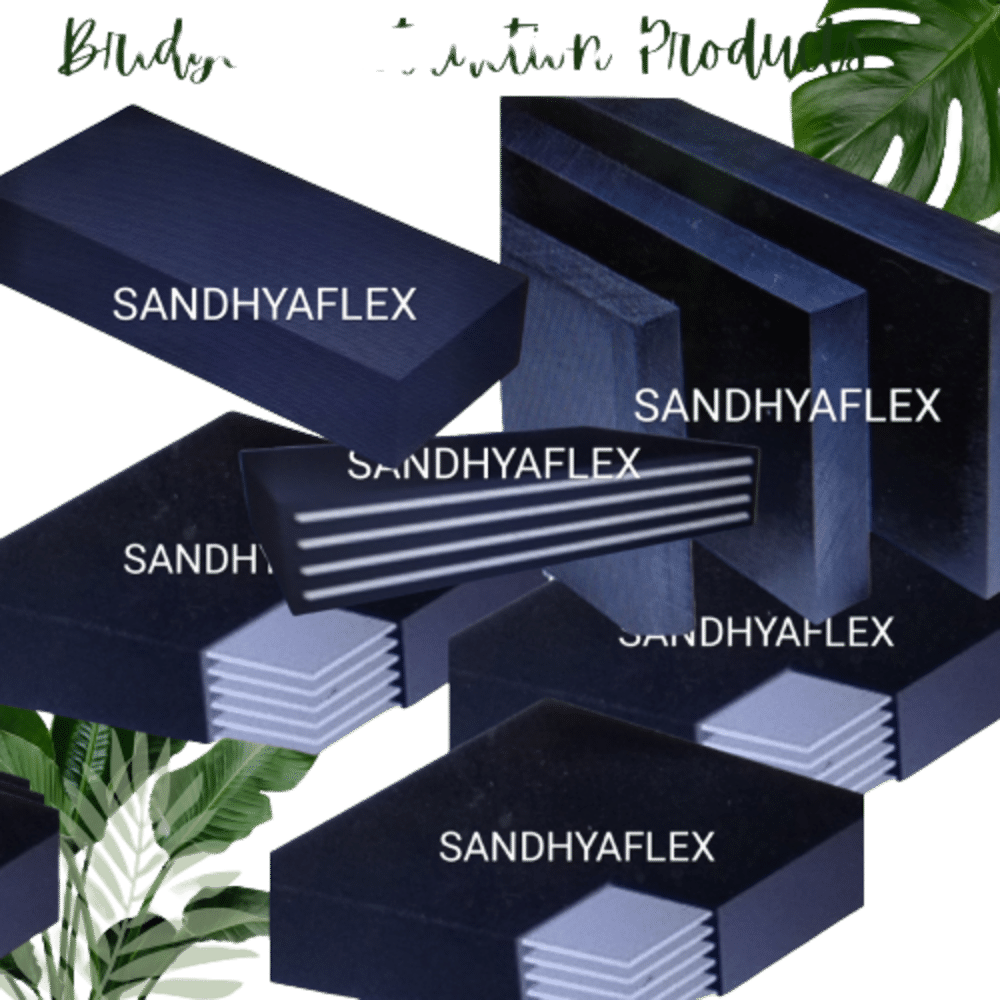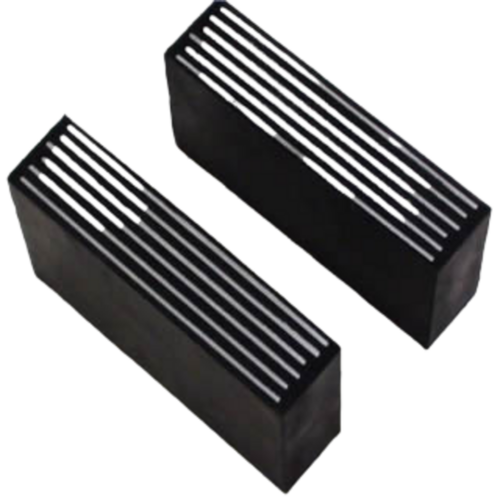Elastomeric Bridge Bearing
Price 0.36 INR/ Piece
Elastomeric Bridge Bearing Specification
- Lubrication Type
- Other
- Usage
- Bridge Construction
- Bearing Type
- Other
- Size
- 22mm to 144mm
- Material
- Carbon Steel
- Product Type
- Elastomeric Bridge Bearing
- Number Of Rows
- Single Row
- Color
- Black
- Warranty
- 15 Years date of Manufacturing
Elastomeric Bridge Bearing Trade Information
- Minimum Order Quantity
- 100000 Pieces
- Payment Terms
- Cash in Advance (CID)
- Supply Ability
- 2500000 Pieces Per Day
- Delivery Time
- 15 Days
- Sample Available
- Yes
- Sample Policy
- Sample costs shipping and taxes has to be paid by the buyer
- Packaging Details
- Packing with HDPE Cover
- Main Export Market(s)
- Asia
- Main Domestic Market
- All India
- Certifications
- ISO 9001 2018
About Elastomeric Bridge Bearing
Offered 22mm Elastomeric Bridge Bearing is designed to transform the movement and rotation of bridge structure into elasticity and minimizes the secondary stress generated in bridge because of the layered rubber sheets reinforced by metal plates. It effectively release the stress on the bridge and have excellent rotation in all the directions and movements. It is highly demanded for its exclusive quality, fitment and performance. Apart from this, 22mm Elastomeric Bridge Bearing can be availed from us at affordable price.
Offering the finestElastomeric Bridge Bearing, Sandhya Flex takes pleasure as a leading manufacturer of the products. We have segregated our infrastructure into several units with one of them as packaging unit. Here we meticulously pack our Elastomeric Bridge Bearing to ensure safe and secure deliverables. For the safe storage of the manufactured products, we have installed our facility equipped with all the modern amenities for absolute quality satisfaction.
The features of the elastomeric bridge bearing involve a strong design, simple installation and high quality. Also, it allows movement in all the directions you desire. Moreover, it finds it application in bridges, auditoriums, buildings and stadiums among others. They have exceptional tensile strength along with good elongation strength.
They are easy to install for various applications. Above all, they require less maintenance as well. They are precisely manufactured by specialists and experts as per the national and international norms and standards. Also, we use premium quality raw material to manufacture these elastomeric bridge bearing which are sourced from reliable vendors. Further, we assure the best quality, superior performing, durable and energy-efficient elastomeric bridge bearing which you can get from Sandhya Flex at competitive prices in the market.
Elastomeric bridge bearings are devices used in bridge construction and infrastructure to accommodate movements and rotations between different bridge components. These bearings are made from a type of synthetic rubber known as elastomer, which has excellent elasticity and resilience properties.
The primary purpose of elastomeric bridge bearings is to distribute and transmit loads, such as the weight of the bridge itself, traffic loads, and environmental forces, while allowing for controlled movement and rotation. They provide flexibility and prevent the transfer of excessive stress to bridge components, thus protecting the structure from damage and ensuring its durability.
Here are some key features and benefits of elastomeric bridge bearings:
1. Load Distribution: Elastomeric bearings can distribute loads over a larger surface area, reducing the stress concentration on specific bridge elements. They help prevent localized damage and premature wear.
2. Movement and Rotation: These bearings can accommodate horizontal and vertical movements, as well as rotations, caused by factors such as thermal expansion and contraction, traffic loads, and seismic activity. They allow the bridge components to adjust and move without causing excessive stress or damage.
3. Vibration Damping: Elastomeric materials have excellent vibration damping properties, reducing the transmission of vibrations caused by traffic or environmental factors. This helps improve ride comfort and reduces the potential for fatigue in the bridge structure.
4. Durability and Longevity: Elastomeric bearings are designed to withstand long-term exposure to environmental conditions, including temperature variations, moisture, and chemical exposure. They have a long service life and require minimal maintenance.
5. Cost-Effectiveness: Compared to alternative bearing systems, such as roller bearings, elastomeric bearings are often more cost-effective in terms of initial installation and long-term maintenance costs.
It's important to note that elastomeric bridge bearings come in various shapes and designs to accommodate different bridge configurations and load requirements. These include laminated elastomeric bearings, pot bearings, and spherical bearings, among others. The specific type of bearing used depends on factors such as bridge design, expected movements, and load conditions.
Overall, elastomeric bridge bearings play a crucial role in ensuring the structural integrity and functionality of bridges by allowing controlled movements and distributing loads effectively.
An elastomeric bridge bearing is a component used in bridge construction and infrastructure projects to facilitate the movement, rotation, and load transfer between bridge elements. It provides support and flexibility while accommodating the forces and displacements caused by temperature variations, traffic loads, and seismic activity. Here are the specifications and features of a typical elastomeric bridge bearing:
1. Material: Elastomeric bridge bearings are typically made from high-quality synthetic rubber compounds, such as natural rubber or neoprene. These materials exhibit excellent elasticity, durability, and resistance to weathering, chemicals, and UV exposure.
2. Design: Elastomeric bridge bearings are available in various designs and configurations, depending on the specific application and bridge requirements. Common designs include laminated bearings, pot bearings, and disc bearings.
3. Load Capacity: Elastomeric bridge bearings are designed to withstand vertical loads, horizontal forces, and rotational movements. The load capacity is specified in terms of maximum vertical load, horizontal load, and rotational capacity to ensure safe and reliable bridge performance.
4. Movement Capacity: Elastomeric bridge bearings allow for both translational and rotational movements, accommodating the expansion, contraction, and lateral displacements of the bridge structure. The movement capacity is specified in terms of maximum displacement or deflection to ensure proper functioning of the bearing.
5. Damping and Isolation: Elastomeric bridge bearings provide damping characteristics, helping to dissipate vibrations and reduce the transmission of forces to the bridge superstructure. They also offer isolation properties, mitigating the impact of external vibrations and seismic activity on the bridge.
6. Durability: Elastomeric bridge bearings are designed to withstand long-term exposure to environmental conditions, including temperature variations, moisture, and UV radiation. They should exhibit excellent resistance to aging, abrasion, and deterioration.
7. Installation: Elastomeric bridge bearings are typically installed using appropriate anchoring systems or fixing methods. The installation process ensures proper alignment, secure attachment, and load transfer between the bearing and the bridge components.
8. Compliance: Elastomeric bridge bearings may need to comply with specific industry standards or regulations, such as those set by organizations like the American Association of State Highway and Transportation Officials (AASHTO) or the International Organization for Standardization (ISO).
It's important to note that the exact specifications of an elastomeric bridge bearing can vary depending on the manufacturer, application, and bridge design requirements. Therefore, it's advisable to consult the product documentation or contact the manufacturer for detailed information regarding a specific elastomeric bridge bearing's specifications.
Engineered for Structural Reliability
Our Elastomeric Bridge Bearings are meticulously crafted from high-quality carbon steel, tailored to withstand heavy loads and bridge movements. The single-row configuration ensures focused strength and adaptability, making them ideal for modern bridge construction across diverse terrains.
Wide Application Range and Sizing
Available in sizes from 22mm to 144mm, these bearings cater to varied bridge designs and load conditions. Their black finish enhances resistance against environmental stress, ensuring stability and safety throughout their 15-year warranty period.
FAQ's of Elastomeric Bridge Bearing:
Q: How are elastomeric bridge bearings installed during bridge construction?
A: Elastomeric bridge bearings are installed by placing them between the bridge superstructure and substructure. This process involves precise alignment and ensures that the bearing transfers loads while accommodating movements due to thermal expansion, load variation, and seismic activity.Q: What is the primary benefit of using carbon steel elastomeric bearings in bridges?
A: Carbon steel elastomeric bearings offer exceptional durability and load-bearing capacity. They efficiently distribute structural forces and allow longitudinal and rotational movements, reducing stress on the bridge components for enhanced longevity.Q: When should elastomeric bridge bearings be replaced or inspected?
A: It is recommended to inspect elastomeric bearings regularly as part of routine bridge maintenance. Replacements are generally considered after the 15-year warranty period or if signs of severe wear, deformation, or corrosion are observed.Q: Where can I purchase these elastomeric bridge bearings in India?
A: These bearings are available through multiple channels, including dealers, fabricators, manufacturers, producers, retailers, suppliers, traders, and wholesalers across India. You can contact your preferred local or national distributor for supply details.Q: What is the process for customizing the bearing size for specific bridge projects?
A: You can consult with the manufacturer or supplier to specify the required size within the 22mm to 144mm range. Custom fabrication ensures the bearing matches your bridge's design parameters and load requirements.Q: How do these bearings accommodate bridge movement and expansion?
A: The elastomeric construction enables the bearing to absorb and accommodate vertical, horizontal, and rotational displacements caused by traffic loads, temperature changes, and ground movement, thus safeguarding the bridge structure.Q: What usage advantages do these elastomeric bridge bearings provide to bridge projects?
A: They enhance bridge safety, distribute loads uniformly, and extend the lifespan of bridge decks by minimizing direct structural wear and improving performance over the 15-year warranty period.











Price:
- 50
- 100
- 200
- 250
- 500
- 1000+
More Products in Elastomeric Bridge Bearing Category
Heavy Duty Elastomeric Bridge Bearing
Price 3265 INR / Cubic Centimeter
Minimum Order Quantity : 100 Cubic Centimeters
Size : 500 x 320 x 80mm
Material : Rubber
Product Type : Elastomeric Bridge Bearing
Thickness : 22 to 144 Millimeter (mm)
Industrial Elastomeric Bridge Bearing
Price 6500.0 INR / Piece
Minimum Order Quantity : 1000 Pieces
Size : 500x400x96mm
Material : Rubber
Product Type : Elastomeric Bridge Bearing
Thickness : 96+5% Millimeter (mm)

 Send Inquiry
Send Inquiry






 Send Inquiry
Send Inquiry Send SMS
Send SMS Call Me Free
Call Me Free